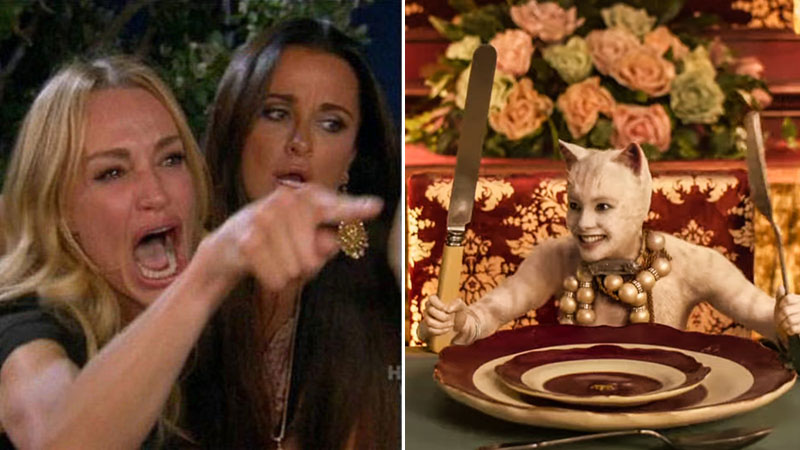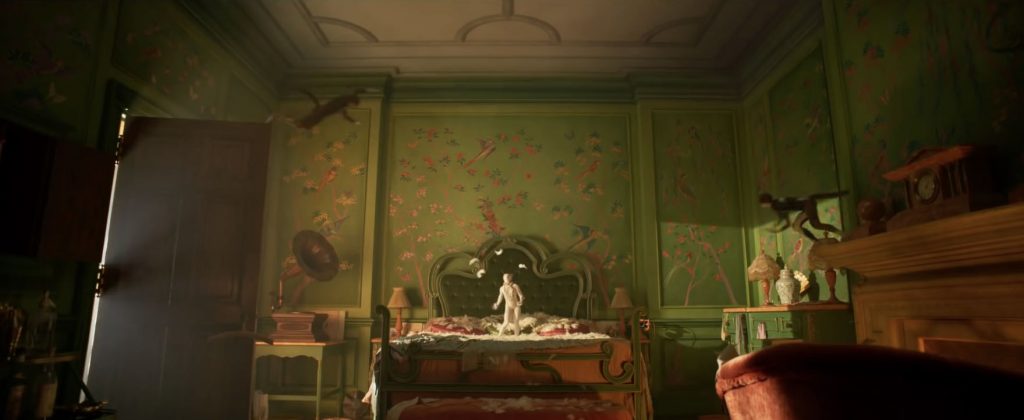Almost forty years after the spectacle-driven dance concert debuted in London, and almost six weeks after this blog post was written, the film adaptation CATS (2019, dir. Tom Hooper) will be released in theaters. The tagline “You Will Believe” would be better written as “You Should Suspend Your Disbelief.”
The official trailer was released on YouTube in July 2019 and, as of October 2019, has well over 1.8 million views. I estimate only 30 of these were generated by your humble author, who I readily admit is an unrepentant CATS stan. However, much of the press at the time of the release was focused on the design of the human/cat hybrids and to what degree their design could be considered horrific. I argue that, though the image of the cats is unsettling, the design is inspired in that it has achieved a sense of the Uncanny without dipping into the Uncanny Valley.

The original design of the cats in CATS for the stage looked something like New Wave Werewolves. The performers wore painted leotards and fright wigs with tufted ears, as well as catlike features painted on their faces. Theater, by its nature, not only allows but is dependent on some measure of conversation between the production design and the audience for the duration of the performance. There is, ironically, more space to suspend disbelief when the space is shared. The production never suggests that its intention is to present the performers as “being” cats, only as “performing” cats. The difficulties in translating from theater to film is also crucial in understanding the design of CATS. The cats of the film CATS have a humanoid build, as well as the familiar curves and contours of the performers’ bodies, enhanced by photorealistic rendered fur and whiskers. These celebrity chimeras, like something out of Derrida’s very early morning dreams, are inherently uneasy in that they are images of human/animal hybrids. The uneasy image is supported by the design as deliberate by the vibrant, glossy cinematography and the malleable scale of the funhouse sets.

But so far as the legacy of computer animation has been marked by its technological progress, the capacity for more photorealistic rendering, rather than creating a style that supports the themes or plot of a film, has been understood to be the mark of achievement in the art form. In CATS, the already uncanny combination of human and animal is best supported by creating an uneasy image. And as a text that is indebted to its capacity for spectacle, an uneasy image is the most satisfying spectacle for an image-inundated audience in 2019. Sontag’s Notes on Camp articulates that pure Camp is naive, in that it is deadly serious in its understanding of itself, but it ultimately fails to inspire that seriousness to its audience (see Sontag 2009, 275). Pure Camp must also be extravagant and excessive in its image-making. Within this framework, there can be no deliberate Camp, only deliberate excess. Purposely outrageous and excessive image-making that aspires to be Camp is often merely bad. But to make an uneasy image for the purpose of taking delight in the unease is, while adjacent to Camp, separate in both intention and articulation. While creating an uneasy image for the purpose of supporting horror is simply horror, creating an uneasy image for the purpose of inspiring delight could be considered a sort of Post-Camp. And that Post-Camp is reliant on the aesthetic savviness of an audience. Our image-saturated audience must also contend with paratext concerning what images are valuable, true, and trustworthy. The “poor” image, degraded and made accessible and memetic through that degradation, has found itself to embody an aesthetic pleasure and verisimilitude separate from its index. The slick, glossy, overproduced look of CATS signifies and supports itself as spectacle not in that it is deliberately bad, but in that it is deliberately fake. But why would this production choice work for a contemporary audience, who marvels not on how the cats are hybridized, but on why they are hybridized?

“I never thought we would have a president with a combover,” remarked Lauren Berlant in a lecture (Berlant, 2017). There are undeniably, if hitherto undefinably, new aesthetic operations intersecting our received understanding of images that represent “fact” and “truth.”
We live in an era of “fake news,” where the authoritative language of broadcast news has been applied as a veneer to legitimize fringe political actors who can produce the correct aesthetic. We also live in an era of “deep fakes,” where photorealistic moving images are created with computer learning, creating more and more accessibility by smaller and smaller groups to propaganda creation. The stakes of image-making and the responsibilities of spectatorship are undeniably high.
This is not to say that the sole function of CATS is to inspire a riot against the aesthetic zeitgeist. I first fell in love with the play because it had my five favorite things: fright wigs, synthesizers, the word “jellicle,” spooky poetry, and of course, cats. The story, which centers on a conclave of weirdos dancing their little kitty hearts out for a place in cat heaven, is deeply apolitical. It is a bold choice to create an “incorrect” aesthetic, an uneasy (and therefore easily dismissible) image to signify entertainment and support aesthetic pleasure. Like the relationship between a theatrical audience and a performance, the pleasure for the film audience of CATS begins, once again, with knowing that the cats are being “performed.” And if you are anything like your humble author, that pleasure continues by scream-singing “Memory” at all your friends until opening day.
References
Berlant, Lauren (2017). “Humorlessness/Comedy.” Lecture, CalArts West Hollywood Aesthetics and Politics Series, Los Angeles, February 3.
Derrida, Jacques, and Marie-Louise Mallet (2010). The Animal That Therefore I Am, New York: Fordham University Press.
Gilbert, Sophie (2019). “I Watched the ‘Cats’ Trailer, and I Have Some Questions”, The Atlantic, July 19, https://www.theatlantic.com/entertainment/archive/2019/07/cats-trailer-questions/594367/ [Accessed on October 23, 2019].
Glynn, Paul (2019). “Cats: Claws out for Movie Trailer”, BBC News. July 19, https://www.bbc.com/news/entertainment-arts-49015496 [Accessed on October 23, 2019].
Schwartz, Oscar (2018). “You Thought Fake News Was Bad? Deep Fakes Are Where Truth Goes to Die”, The Guardian, November 12, https://www.theguardian.com/technology/2018/nov/12/deep-fakes-fake-news-truth [Accessed on October 23, 2019].
Sontag, Susan (2009). Against Interpretation and Other Essays, London: Penguin.
Steyerl, Hito (2009). “In Defense of the Poor Image”, e-flux, November, https://www.e-flux.com/journal/10/61362/in-defense-of-the-poor-image/ [Accessed on October 23, 2019].
Devlin Grimm is a Creative Theorist, Dramaturge, and Art Educat biased in Los Angeles. Her research interests include performance studies, mass media studies, and humor. She holds an MA in Aesthetics and Politics from the California Institute of the Arts.

1 comment for “Allegorical Cats, Metaphorical Cats: “CATS” and the Pleasure of an Uneasy Image”